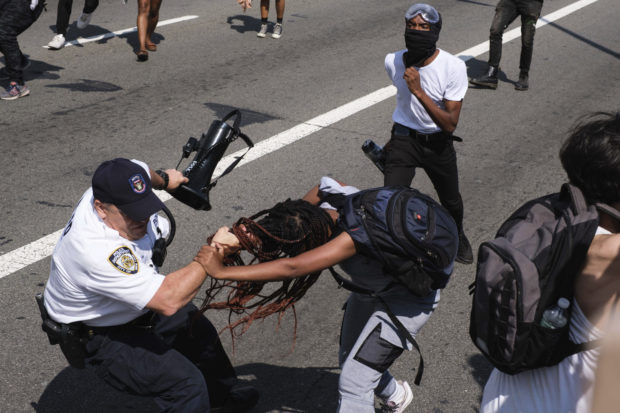NYPD chief, protesters roughed up in Brooklyn Bridge clash
NEW YORK — Several New York City police officers were attacked and injured Wednesday as pro-police and anti-police protesters clashed on the Brooklyn Bridge, police said.

Black Lives Matter protesters scuffle with an NYPD officer on the Brooklyn Bridge in New York during a demonstration Wednesday, July 15, 2020. Several New York City police officers were attacked and injured during the protest, police said, and more than a dozen people were arrested. (AP Photo/Yuki Iwamura)
The confrontation happened hours before Mayor Bill de Blasio signed into law a series of police accountability measures inspired by the killings of George Floyd, Eric Garner and other Black people.
At least four officers were hurt, including Chief of Department Terence Monahan, and 37 people were arrested, police said. Information on charges was not immediately available.
It was not clear how many protesters were injured. An Associated Press photographer witnessed several people getting roughed up by police, including a woman who ended up on the pavement with an officer pulling on her hair.
Surveillance video posted on social media by the police department showed a man on the bridge’s pedestrian walkway rushing toward a group of officers and reaching over a fence to smack one of them in the head with a cane.
Police photos of the aftermath showed a lieutenant with a bloodied face, a detective holding a bandage to his head, and a bicycle officer helping a fellow officer dress a head wound.
Article continues after this advertisementMonahan, who last month knelt in a show of solidarity with protesters, sustained injuries to his hand.
Article continues after this advertisementHe and the other injured officers were marching with a pro-police group led by local clergy when they were met on the bridge by activists, some of whom have been camping outside City Hall in recent weeks to demand severe cuts to police funding.
Some people in the pro-police group marched with a banner that said, “We Support the NYPD.” The leader of that group said they were calling for an end to a recent spate of violence, including the shooting death of a 1-year-old boy in Brooklyn.
De Blasio helped paint a Black Lives Matter mural on a Bronx street before signing the police reform measures. They include a ban on chokeholds and other restraints that could restrict a person’s breathing. The NYPD has long barred chokeholds, but that hasn’t stopped some officers from using them in recent years — most notably in Garner’s death on Staten Island just shy of six years ago.
Other reforms include requirements for officers to have their shield numbers visible — and not obscured by things like black mourning bands; for the NYPD to create and publish to its website a schedule of officer disciplinary violations and penalties, and for the department to disclose information about its secret surveillance technology.
Another makes clear that the public has a right to record police activity.
Wednesday’s demonstrations and mural painting were the latest in a wave of protest activity across the country since George Floyd was killed May 25 by Minneapolis police.
The first few nights of protests in New York City were marred by stealing, unrest and violence inflicted both by and on police officers. Since then, protests have largely been peaceful.